995 scholarly books by The Institution of Engineering and Technology and 80
start with E
995 scholarly books by The Institution of Engineering and Technology and 80
995 scholarly books by The Institution of Engineering and Technology
80 start with E start with E
80 start with E start with E

The Early History of Radio
From Faraday to Marconi
G.R.M. Garratt
The Institution of Engineering and Technology, 1994
Much has been written about Faraday and Marconi, and about the history of the development of radio from the time of Marconi. However, Gerald Garratt's special interest was in what might be termed the 'prehistory' of radio. This book therefore outlines the sequence of development from Faraday's first prediction and concept of the electromagnetic field: Maxwell worked out the mathematics of electromagnetic wave propagation and Hertz demonstrated their physical existence. Lodge identified the need for resonance between transmitter and receiver, thus leading to Marconi's successful practical application.
[more]

Earth Observation Data Analytics Using Machine and Deep Learning
Modern tools, applications and challenges
Sanjay Garg
The Institution of Engineering and Technology, 2023
Earth Observation Data Analytics Using Machine and Deep Learning: Modern tools, applications and challenges covers the basic properties, features and models for Earth observation (EO) recorded by very high-resolution (VHR) multispectral, hyperspectral, synthetic aperture radar (SAR), and multi-temporal observations.
[more]

Economic Evaluation of Projects in the Electricity Supply Industry
Hisham Khatib
The Institution of Engineering and Technology, 2014
In the highly capital-intensive electricity supply industry, it is essential that both engineers and managers understand the methodologies of project evaluation in order to comprehend and analyse investment proposals and decisions. This updated and expanded edition of Economic Evaluation of Projects in the Electricity Supply Industry takes a broad introductory approach, covering planning and investment, financial analysis and evaluation, risk management, electricity trading, and strategies, technologies, national requirements and global agreements for electricity generation in a carbon-constrained world.
[more]

Economic Evaluation of Projects in the Electricity Supply Industry
Hisham Khatib
The Institution of Engineering and Technology, 2003
In the highly capital-intensive electricity supply industry, it is essential that both engineers and managers understand the methodologies of project evaluation in order to comprehend and analyse investment proposals and decisions. This fully revised and updated edition of Economic Evaluation of Projects in the Electricity Supply Industry (1996) takes a broad introductory approach, covering market and environmental issues, financial analysis and evaluation, and clean environmental technologies and costs. New topics include electricity trading and risk management, evolving electricity utilities and new and future generation technologies in a carbon-constrained world.
[more]
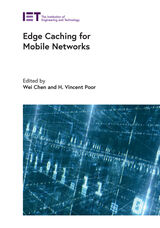
Edge Caching for Mobile Networks
Wei Chen
The Institution of Engineering and Technology, 2022
Caching enables the storage of Internet-based content, including web objects, videos and software updates. When web objects are downloaded from the Internet or across wide-area-network (WAN) links, edge caching stores them at the edge of the network. Content can also be proactively cached at the edge based on its predicted popularity. When subsequent requests come for cached material, the content is quickly delivered from edge caching, without the need to download the data again over the WAN. The result is the ability to help save bandwidth, particularly at times of peak network load, increase content delivery, and provide users with a faster and better network experience.
[more]
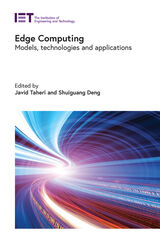
Edge Computing
Models, technologies and applications
Javid Taheri
The Institution of Engineering and Technology, 2020
Cloud computing has evolved as a cost-effective, easy-to-use, elastic and scalable computing paradigm to transform today's business models. 5G, Industrial IoT, Industry 4.0 and China-2050 frameworks and technologies are introducing new challenges that cannot be solved efficiently using current cloud architectures. To handle the collected information from such a vast number of devices and actuators, and address these issues, novel concepts have been proposed to bring cloud-like resources closer to end users at the edge of the network, a technology called edge computing.
[more]
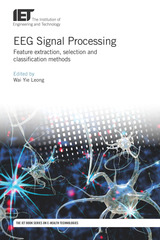
EEG Signal Processing
Feature extraction, selection and classification methods
Wai Yie Leong
The Institution of Engineering and Technology, 2019
Electroencephalography (EEG) is an electrophysiological monitoring method used to record the brain activity in brain-computer interface (BCI) systems. It records the electrical activity of the brain, is typically non-invasive with electrodes placed along the scalp, requires relatively simple and inexpensive equipment, and is easier to use than other methods.
[more]
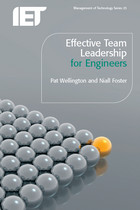
Effective Team Leadership for Engineers
Pat Wellington
The Institution of Engineering and Technology, 2009
This book is a must for engineers who have just, or will soon, become team leaders. It is also an essential guide for more experienced team and project leaders who wish to brush up their skills and knowledge.
[more]
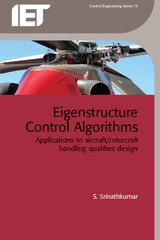
Eigenstructure Control Algorithms
Applications to aircraft/rotorcraft handling qualities design
S. Srinathkumar
The Institution of Engineering and Technology, 2011
Eigenstructure control involves modification of both the eigenvalues and eigenvectors of a system using feedback. Based on this key concept, algorithms are derived for the design of control systems using controller structures such as state feedback, output feedback, observer-based dynamic feedback, implicit and explicit modelfollowing, etc. The simple-to-use algorithms are well suited to evolve practical engineering solutions.
[more]
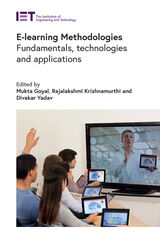
E-learning Methodologies
Fundamentals, technologies and applications
Mukta Goyal
The Institution of Engineering and Technology, 2021
E-learning has become an important part of our educational life with the development of e-learning systems and platforms and the need for online and remote learning. ICT and computational intelligence techniques are being used to design more intelligent and adaptive systems. However, the art of designing good real-time e-learning systems is difficult as different aspects of learning need to be considered including challenges such as learning rates, involvement, knowledge, qualifications, as well as networking and security issues. The earlier concepts of standalone integrated virtual e-learning systems have been greatly enhanced with emerging technologies such as cloud computing, mobile computing, big data, Internet of Things (IoT), AI and machine learning, and AR/VT technologies.
[more]

The Electric Car
Development and future of battery, hybrid and fuel-cell cars
Mike H. Westbrook
The Institution of Engineering and Technology, 2001
This book covers the development of electric cars from their early days to pure electric, fuel-cell and new hybrid models in production. It covers the latest technological issues faced by automotive engineers working on electric cars, including charging, infrastructure, safety and costs, as well as making predictions about future developments and vehicle numbers. Considerable work has gone into electric car and battery development in the last ten years, with the prospect of substantial improvements in range and performance in battery cars as well as in hybrids and those using fuel cells. The book comprehensively covers this important subject and will be of particular interest to engineers working on electric vehicle design, development and use, as well as managers interested in the key business factors vital for the successful transfer of electric cars into the mass market.
[more]

Electric Fuses
A. Wright
The Institution of Engineering and Technology, 2004
Wright and Newbery's classic guide to the world of electric fuses has been substantially revised and remains the comprehensive reference work on the subject.
[more]

Electric Fuses
Fundamentals and new applications
Nigel Nurse
The Institution of Engineering and Technology, 2022
Fuses are designed to operate when over-currents, large and small, occur within electrical equipment; they thus interrupt the flow of current, preventing damage. They are needed for various power electric systems, for stationary and automotive applications, as well as power grid components like PV systems and distribution lines. Different types of equipment and voltages require special fuses, and their behaviour must be understood to guarantee correct choice and safe operation.
[more]

Electric Railways
1880-1990
Michael C. Duffy
The Institution of Engineering and Technology, 2003
Electric Railways 1880-1990 explores the history of the integration of both electric and diesel-electric railway systems and identifies the crucial role that diesel-electric traction played in the development of wireless electrification. The evolution of electrical technology and the modern railway produced innovations in engineering that were integral to the development of traction, power and signalling systems. This book presents a thorough survey of electric railway development from the earliest days pf the London Underground to modern electrified main line trains. The distinction between 'enforced electrification' and 'economic electrification' is also discussed and the pioneering role of J.J. Heilmann assessed.
[more]
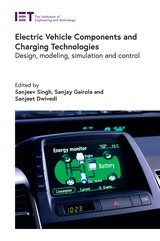
Electric Vehicle Components and Charging Technologies
Design, modeling, simulation and control
Sanjeev Singh
The Institution of Engineering and Technology, 2024
In order to create a reliable, safe and cost-effective electric vehicle with acceptable range, battery charging time, battery life and driving performance, it is important to design optimised and compatible components and charging systems.
[more]
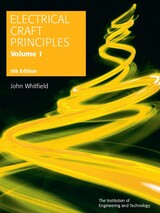
Electrical Craft Principles, Volume 1
John Whitfield
The Institution of Engineering and Technology, 2009
This is the first of a two-volume work covering the electrical principles syllabuses of all of the major examining bodies including the City & Guilds of London Institute's electrical craft courses. It is also suitable for a wide range of other courses, including the first three years of the BTEC electrical series. Great care has been taken to ensure that the text fully covers the content of the syllabuses concerned, both as published and as interpreted by the examiners in the past.
[more]

Electrical Craft Principles, Volume 2
John Whitfield
The Institution of Engineering and Technology, 2009
This is the second of a two-volume work covering the electrical principles syllabuses of all of the major examining bodies including the City & Guilds of London Institute's electrical craft courses. It is also suitable for a wide range of other courses, including the first three years of the BTEC electrical series. Great care has been taken to ensure that the text fully covers the content of the syllabuses concerned, both as published and as interpreted by the examiners in the past.
[more]

Electrical Degradation and Breakdown in Polymers
L.A. Dissado
The Institution of Engineering and Technology, 1992
Breakdown is fascinating to the scientist and frustrating to the engineer! As well as advancing the scientific and engineering understanding of electrical degradation and breakdown in polymers, this book forms a comprehensive and international review of the state-of-the-art. Topics include: water and electrical treeing; charge transport; 'classical' and filamentary thermal, electromechanical, electronic and partial discharge breakdown models; the stochastic nature of breakdown and statistical characterisation techniques; and engineering considerations for breakdown testing and degradation assessment. The treatment presumes little prior knowledge but develops into an advanced understanding of new concepts such as the fractal-like nature of trees. Although the book is primarily aimed at scientists and engineers practising in the field, a broad introductory section has been included to cater for a wide audience including those new to the subject area. This comprises a description of the nature of the polymers, basic solid-state physics and an introduction to degradation and breakdown.
[more]
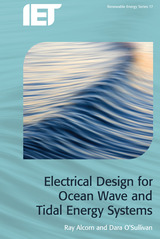
Electrical Design for Ocean Wave and Tidal Energy Systems
Raymond Alcorn
The Institution of Engineering and Technology, 2013
Renewable energy is expected to play a major part in future energy supplies, both to reduce the impact on the world climate and also to make up for any shortfall in conventional energy sources. Ocean energy has the potential to make a significant contribution to future renewable energy supplies as identified in recent reports from the Intergovernmental Panel for Climate Change and the International Energy Agency. Ocean energy is an emerging industry sector and there are a number of promising developments under way. Significant commercial deployments in the gigawatt range are envisaged over the next 10 to 20 years in Europe, USA, Asia and South America.
[more]

Electrical Installation Design Guide
Calculations for Electricians and Designers
The Institution of Engineering and Technology
The Institution of Engineering and Technology, 2022
Electrical Installation Design Guide: Calculations for Electricians and Designers provides step-by-step guidance on the design of electrical installations. The guide will be useful for apprentices and trainees carrying out the calculations necessary for a basic installation and has been fully updated to BS 7671:2018+A2:2022.
[more]

Electrical Installation Design Guide
Calculations for Electricians and Designers
The Institution of Engineering and Technology
The Institution of Engineering and Technology, 2019
Electrical Installation Design Guide: Calculations for Electricians and Designers provides step-by-step guidance on the design of electrical installations. The guide will be useful for apprentices and trainees carrying out the calculations necessary for a basic installation and has been fully updated to BS 7671:2018.
[more]

Electrical Installation Design Guide
Calculations for Electricians and Designers
The Institution of Engineering and Technology
The Institution of Engineering and Technology, 2016
The book provides step-by-step guidance on the design of electrical installations, from domestic installation final circuit design to fault level calculations for LV systems.
[more]
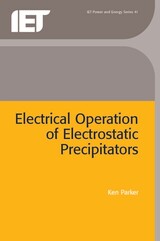
Electrical Operation of Electrostatic Precipitators
Ken Parker
The Institution of Engineering and Technology, 2003
The electrostatic precipitator remains one of the most cost-effective means of controlling the emission of particulates from most industrial processes, including pollution from power stations. The author reviews the basic theory and operation of precipitators, the characteristics of gas and particulates that impact on design and operation, and the design of high- and mains-frequency rectification equipment. Chapters also cover performance monitoring and enhancement, and fault detection.
[more]

Electrical Safety
A guide to the causes and prevention of electrical hazards
J. Maxwell Adams
The Institution of Engineering and Technology, 1994
This book explains the hazards associated with electricity in its many forms, including electromagnetic radiation. It describes methods of reducing risks to health and to the environment, giving rules and codes of practice to be followed. Guidelines are also given for the use of electrical equipment in specialised environments (such as locations subject to explosive gases and flammable dusts), the guarding of machine tools and the control of earth currents.
[more]

Electrical Steels for Rotating Machines
Philip Beckley
The Institution of Engineering and Technology, 2002
Electrical steels are used to form the ferromagnetic cores of motors, generators and transformers. This book provides an insight for the electrical design engineer into what properties may be expected from electrical steels and how these properties may best be exploited in machine design.
[more]
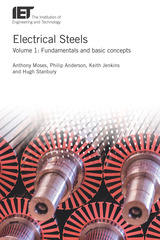
Electrical Steels
Fundamentals and basic concepts, Volume 1
Anthony Moses
The Institution of Engineering and Technology, 2019
Electrical steels are critical components of magnetic cores used in applications ranging from large rotating machines, including energy generating equipment, and transformers to small instrument transformers and harmonic filters. Presented over two volumes, this comprehensive handbook provides full coverage of the state-of-the-art in electrical steels.
[more]
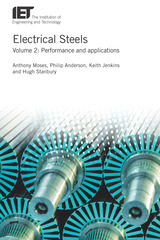
Electrical Steels
Performance and applications, Volume 2
Anthony Moses
The Institution of Engineering and Technology, 2019
Electrical steels are critical components of magnetic cores used in applications ranging from large rotating machines, including energy generating equipment, and transformers to small instrument transformers and harmonic filters. Presented over two volumes, this comprehensive handbook provides full coverage of the state-of-the-art in electrical steels.
[more]

Electrical Steels
Production, characterisation and applications
Anthony Moses
The Institution of Engineering and Technology, 2019
This comprehensive, must-read reference covers the production, characterisation and applications of electrical steels. A range of uses are discussed, with renewable power generation covered in particular. The authors present the material in a systematic way, covering production, measurements, standards, uses, and a number of other important aspects, making it essential reading for any engineers and scientists working in the electrical generation and distribution sectors.
[more]

Electricity Distribution Network Design
E. Lakervi
The Institution of Engineering and Technology, 2003
Distribution networks represent a huge capital investment. To make sensible decisions about their investments, electricity utilities need to form clear-cut design policies and adopt the most accurate systemdesign procedures.
[more]

Electricity Economics and Planning
T.W. Berrie
The Institution of Engineering and Technology, 1992
This book is unique in gathering under one over all the elements of electricity economics and planning, both for the traditional approach and for the new developments of the 1990s, e.g. privatisation, competition, deregulation and more efficient markets and pricing. All the fundamental institutional aspects of electricity in the 1990s are also discussed, particularly relevant at a time when the utilities of the developed world are being restructured, those of the ex-centrally planned economies are being profoundly reorganised and those of developing countries have enormous debt problems. The book describes how these challenges of the 1990s are to be understood and met.
[more]

Electrochemical Power Sources
Primary and secondary batteries
M. Barak
The Institution of Engineering and Technology, 1980
The variety and scope of primary and secondary battery applications in domestic goods and capital equipment for civilian and military uses has steadily grown over the years. Annual global sales of the battery business are exceeding £4000 million, encouraging a number of books on individual battery systems.
[more]

Electrodynamic Theory of Superconductors
Shu-Ang Zhou
The Institution of Engineering and Technology, 1991
Electrodynamic Theory of Superconductors is the first book of its kind. It gives a unified and comprehensive theoretical treatment of electromagnetic, thermal and mechanical phenomena in superconductors. Basic concepts and principles in continuum electrodynamics are introduced, with particular emphasis on methodology. Electrodynamic models are developed to study magnetoelastic and thermoelastic superconductors. The author also introduces phenomenological London theory, Cinzburg-Landau theory, electrodynamic models for superconducting thin films, AC losses and Josephson junctions, and BCS microscopic theory of superconductivity. This book can be used as a post graduate level text and as a reference book for researchers and engineers working in the field of applied superconductivity and related areas.
[more]
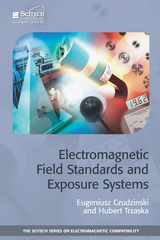
Electromagnetic Field Standards and Exposure Systems
Eugeniusz Grudzinski
The Institution of Engineering and Technology, 2014
Electromagnetic Field Standards and Exposure Systems covers the broader fields of measurements in telecommunications, radio navigation, radio astronomy, bioscience, and free ranging EM radiation and helps to develop the following measurement standards;
[more]
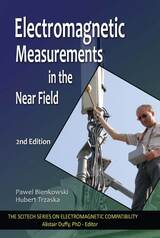
Electromagnetic Measurements in the Near Field
Pawel Bienkowski
The Institution of Engineering and Technology, 2012
This book is devoted to the specific problems of electromagnetic field (EMF) measurements in the near field and to the analysis of the main factors which impede accuracy in these measurements. It focuses on careful and accurate design of systems to measure in the near field based on a thorough understanding of the fundamental engineering principles and on an analysis of the likely system errors. Beginning with a short introduction to electromagnetic fields with an emphasis on the near field, it then presents methods of EMF measurements in near field conditions. It details the factors limiting measurement accuracy including internal ones (thermal stability, frequency response, dynamic characteristics, susceptibility) and external ones (field integration, mutual couplings between a probe and primary and secondary EMF sources, directional pattern deformations). It continues with a discussion on how to gauge the parameters declared by an EMF meter manufacturer and simple methods for testing these parameters. It also details how designers of measuring equipment can reconsider the near field when designing and testing, as well as how users can exploit the knowledge within the book to ensure their tests and results contain the most accurate measurements possible. The SciTech Publishing Series on Electromagnetic Compatibility provides a continuously growing body of knowledge in the latest development and best practices in electromagnetic compatibility engineering. This series provides specialist and non-specialist professionals and students practical knowledge that is thoroughly grounded in relevant theory.
[more]

Electromagnetic Mixing Formulas and Applications
Ari Sihvola
The Institution of Engineering and Technology, 1999
The book discusses homogenisation principles and mixing rules for the determination of the macroscopic dielectric and magnetic properties of different types of media. The effects of structure and anisotropy are discussed in detail, as well as mixtures involving chiral and nonlinear materials. High frequency scattering phenomena and dispersive properties are also discussed.
[more]
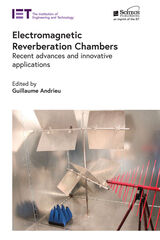
Electromagnetic Reverberation Chambers
Recent advances and innovative applications
Guillaume Andrieu
The Institution of Engineering and Technology, 2021
This book offers state of the art information about a novel range of applications for electromagnetic reverberation chambers. It is written by international experts in electromagnetic theory, electromagnetic compatibility (EMC), and antenna design and measurement.
[more]
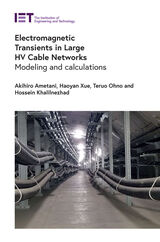
Electromagnetic Transients in Large HV Cable Networks
Modeling and calculations
Akihiro Ametani
The Institution of Engineering and Technology, 2022
Transient events are short-lived bursts of energy in a system resulting from a sudden change of the state. They can be caused by faults, switching events or sudden changes in generation and load. Given the need to expand HV cable grids and to interconnect national grids to increase grid flexibility, the effects of such transients need to be understood in order to maintain the security of power supply and power quality.
[more]

Electromagnetic Waveguides
Theory and applications
S.F. Mahmoud
The Institution of Engineering and Technology, 1991
There are several ways to classify electromagnetic waveguides. Depending on their boundaries, they can be classified into waveguides with perfectly reflecting walls or finite impedance walls, as well as open waveguides. In terms of their applications, there are the low attenuation and low delay distortion waveguides for telecommunication, the low crosspolar field waveguides used as feeds for reflector antennas in frequency reuse schemes, as well as the leaky feeders in continuous access communication systems. There are also the natural waveguides such as tunnels and the earth-ionosphere waveguide.
[more]
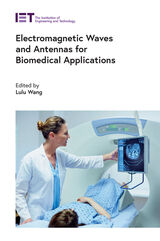
Electromagnetic Waves and Antennas for Biomedical Applications
Lulu Wang
The Institution of Engineering and Technology, 2022
Electromagnetic waves have long been used in medical settings for diagnostic purposes, such as for the detection of cancerous tissues, stroke events or cardiovascular risk, as the behaviour of the waves upon meeting their target gives pertinent information for diagnostic and imaging purposes.
[more]
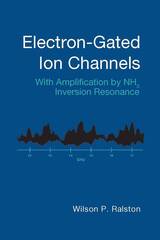
Electron-Gated Ion Channels
With Amplification by NH3 Inversion Resonance
Wilson P. Ralston
The Institution of Engineering and Technology, 2005
Understanding ion channel gating has been a goal of researchers since Hodgkin and Huxley's classic publication in 1952, but the gating mechanism has remained elusive. In this book it is shown how electrons can control gating. Introducing the electron as a gating agent requires amplification, but until now there has been no appropriate mechanism for amplification.
[more]
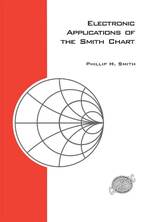
Electronic Applications of the Smith Chart
In waveguide, circuit, and componenet analysis
Phillip H. Smith
The Institution of Engineering and Technology, 1995
This is the second edition of Electronic Applications of the Smith Chart, written by Phillip H. Smith, the originator of the Smith Chart. It covers the history, development and applications of the Smith Chart. This classic reference book describes how the chart is used for designing lumped element and transmission line circuits. The text provides tutorial material on transmission line theory and behavior, circuit representation on the chart, matching networks, network transformations and broadband matching. This edition includes a new chapter with example designs and description of the winSMITH software accessory.
[more]
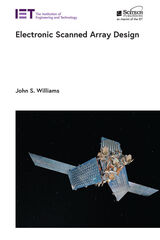
Electronic Scanned Array Design
John S. Williams
The Institution of Engineering and Technology, 2020
Electronic Scanned Array Design covers the fundamental principles of ESA antennas including basic design approaches and inherent design limitations. These insights enable better appreciation of existing and planned ESA systems including their application to earth observation. The material describes general design principles of aperture antennas applied to the specific case of ESA design.
[more]

Electronic Warfare Pocket Guide
David L. Adamy
The Institution of Engineering and Technology, 2011
The Electronic Warfare Pocket Guide is the perfect companion for any user that needs to access key definitions, concepts, and equations for their work in the field, lab, or even in military theater of operations. While this concise guide fits in almost any pocket, it packs a real punch by providing users the answers to real world electronic warfare problems that come up every day in concept development, technique development, system design, system testing, operational testing, mission planning and operations. It is especially useful (if combined with training) for members of the military who are in combat and need to use EW techniques to counter missile-strikes, improvised explosive devices, and other threats. This booklet could usefully go into the pocket of every pilot, sailor, soldier and marine.
[more]
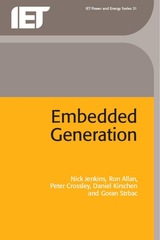
Embedded Generation
Nick Jenkins
The Institution of Engineering and Technology, 2000
The use of combined heat and power (CHP) plants and renewable energy sources reduces the amount of greenhouse gases released into the atmosphere and helps to alleviate the consequent climate change. The policies of many governments suggest that the proportion of electrical energy produced by these sources will increase dramatically over the next two decades. Unlike traditional generating units, these new types of power plant are usually 'embedded' in the distribution system or 'dispersed' around the network. As a result, conventional design and operating practices are no longer applicable; for example, power protection principles have to be revised and complex economic questions need to be resolved.
[more]
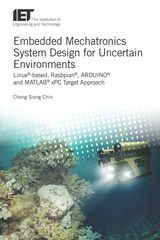
Embedded Mechatronics System Design for Uncertain Environments
Linux®-based, Rasbpian®, ARDUINO® and MATLAB® xPC Target Approaches
Cheng Siong Chin
The Institution of Engineering and Technology, 2019
Industrial machines, automobiles, airplanes, robots, and machines are among the myriad possible hosts of embedded systems. The author researches robotic vehicles and remote operated vehicles (ROVs), especially Underwater Robotic Vehicles (URVs), used for a wide range of applications such as exploring oceans, monitoring environments, and supporting operations in extreme environments.
[more]
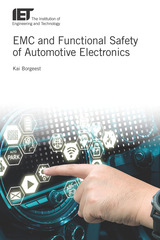
EMC and Functional Safety of Automotive Electronics
Kai Borgeest
The Institution of Engineering and Technology, 2018
Electromagnetic compatibility (EMC) deals with the unintentional propagation and reception of electromagnetic energy which may cause disturbances or even physical damage in electronic or electromechanical systems. With the increase in number and density of electronic devices and systems in modern vehicles, EMC has become a substantial concern and a key cause of malfunction of automotive electronics.
[more]
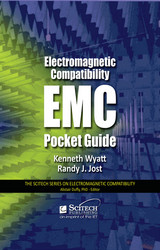
EMC Pocket Guide
Key EMC facts, equations and data
Kenneth Wyatt
The Institution of Engineering and Technology, 2013
Every electric product designed and manufactured worldwide must meet electromagnetic compatibility (EMC) regulations, and yet, EMC compliance staff levels have been cut to the bone in companies large and small. If you are a working engineer or technician, the EMC Pocket Guide: Key EMC facts, equations and data is the first place to look while designing for EMC and your quide to thwarting electromagnetic interference.
[more]
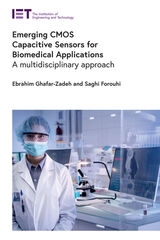
Emerging CMOS Capacitive Sensors for Biomedical Applications
A multidisciplinary approach
Ebrahim Ghafar-Zadeh
The Institution of Engineering and Technology, 2021
CMOS-based sensors offer significant advantages to life science applications, such as non-invasive long-term recordings, fast responses and label-free processes. They have been widely applied in many biological and medical fields for the study of living cell samples such as neural cell recording and stimulation, monitoring metabolic activity, cell manipulation, and extracellular pH monitoring. Compared to other sensing techniques, capacitive sensors are low-complexity, high-precision, label-free sensing methods for monitoring cellular activities such as cell viability, proliferation and morphology.
[more]
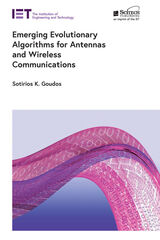
Emerging Evolutionary Algorithms for Antennas and Wireless Communications
Sotirios K. Goudos
The Institution of Engineering and Technology, 2021
Several evolutionary algorithms (EAs) have emerged in recent decades that mimic the behaviour and evolution of biological entities. EAs are widely used to solve single and multi-objective optimization engineering problems. EAs have also been applied to a variety of microwave components, antenna design, radar design, and wireless communications problems. These techniques, among others, include genetic algorithms (GAs), evolution strategies (ES), particle swarm optimization (PSO), differential evolution (DE), and ant colony optimization (ACO). In addition, new innovative algorithms that are not only biology-based but also physics-based or music-based are also emerging, as are hybrid combinations of EAs.
[more]
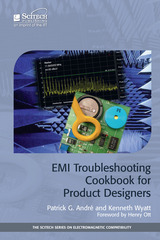
EMI Troubleshooting Cookbook for Product Designers
Patrick G. André
The Institution of Engineering and Technology, 2014
EMI Troubleshooting Cookbook for Product Designers provides the 'recipe' for identifying why products fail to meet EMI/EMC regulatory standards. It also outlines techniques for tracking the noise source, and discovering the coupling mechanism, that is causing the undesired effects.
[more]

Empowering Smart Cities through Community-Centred Public Private Partnerships and Innovations
Debra Lam
The Institution of Engineering and Technology, 2024
Cities are at the heart of the biggest challenges facing humanity - from the cost-of-living crisis to the COVID-19 pandemic, to climate change to inequality and social injustice. Local governments around the world are facing increased expectations to support the transition to a more just and sustainable society and are under pressure to do more with fewer resources. Rapid urbanization is creating significant pressure on cities to expand and improve housing and infrastructure, and improve social equity, health and quality of life, all while fostering a robust economy that can provide good jobs for all. Nonetheless, cities are also our best hope for the future and remain at the heart of economic growth, innovation and job creation.
[more]
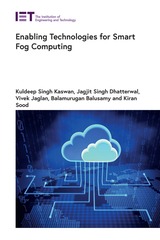
Enabling Technologies for Smart Fog Computing
Kuldeep Singh Kaswan
The Institution of Engineering and Technology, 2024
Fog computing is a decentralized computing infrastructure in which computing resources are located between the data source and the cloud or any other data centers. The word "fog" refers to its cloud-like properties, which are closer to the "ground", using edge devices that carry out locally computation, storage and communication tasks. An additional benefit is that the processed data is likely to be needed by the same devices that generated the data. By processing locally rather than remotely, the latency between input and response are minimized. This technology has countless application domains such as industrial process control, smart cities, transportation, healthcare and agriculture.
[more]
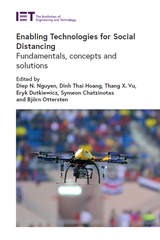
Enabling Technologies for Social Distancing
Fundamentals, concepts and solutions
Diep N. Nguyen
The Institution of Engineering and Technology, 2022
The latest advances in several emerging technologies such as AI, blockchain, privacy-preserving algorithms used in localization and positioning systems, cloud computing and computer vision all have great potential in facilitating social distancing. Benefits range from supporting people to work from home to monitoring micro- and macro- movements such as contact tracing apps using Bluetooth, tracking the movement and transportation level of a city and wireless positioning systems to help people keep a safe distance by alerting them when they are too close to each other or to avoid congestion. However, implementing such technologies in practical scenarios still faces various challenges.
[more]
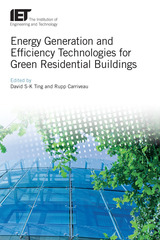
Energy Generation and Efficiency Technologies for Green Residential Buildings
David S-K. Ting
The Institution of Engineering and Technology, 2019
Residential buildings consume about a quarter of all energy (including electrical and thermal) in industrialized countries and emit around 20% of the carbon emissions there. Older and outdated heating and cooling technology causes high energy demand and, depending on building type, secondary causes can include ventilation and lighting. Technology is available to mitigate high energy consumption, and to enable the use of renewable or environmentally friendly energy, partly generated locally.
[more]

Energy Harvesting for Wireless Sensing and Flexible Electronics through Hybrid Technologies
Muhammad Iqbal
The Institution of Engineering and Technology, 2023
As wearable microelectronics are becoming ubiquitous, there is a growing interest in replacing batteries with a means of harnessing power from the user's environment via embedded systems. Efforts have been made to prolong the harvester's operational lifetime, overcoming energy dissipation, lowering resonant frequency, attaining multi-resonant states, and widening the operating frequency bandwidth of the biomechanical energy harvesters. Such technological advances mean harvesting energy is a viable solution for sustainably powering wearable electronics for health and wellbeing applications, such as continuous medical health monitoring, remote sensing, and motion tracking.
[more]
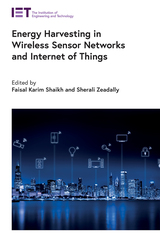
Energy Harvesting in Wireless Sensor Networks and Internet of Things
Faisal Karim Shaikh
The Institution of Engineering and Technology, 2022
The energy efficiency paradigm associated with Wireless Sensor Networks (WSNs) and the Internet of Things (IoT) is a major bottleneck for the development of related technologies. To overcome this limitation, the design and development of efficient and high-performance energy harvesting systems for WSN and IoT environments are being explored.
[more]
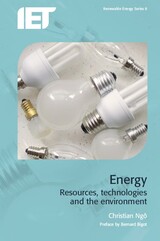
Energy
Resources, technologies and the environment
Christian Ngô
The Institution of Engineering and Technology, 2010
This book is aimed at students and professionals as well as anyone interested in having a global vision and perspective on energy.
[more]
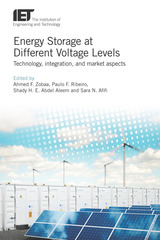
Energy Storage at Different Voltage Levels
Technology, integration, and market aspects
Ahmed F. Zobaa
The Institution of Engineering and Technology, 2018
In an era of increasing contributions from intermittent renewable resources, energy storage is becoming more important to ensure a resilient and reliable electricity supply. Energy Storage at Different Voltage Levels presents the technology, integration and market aspects of energy storage in the various generation, transmission, distribution, and customer levels of the grid.
[more]
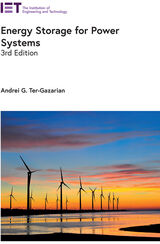
Energy Storage for Power Systems
Andrei G. Ter-Gazarian
The Institution of Engineering and Technology, 2020
Unregulated distributed energy sources such as solar roofs and windmills and electric vehicle requirements for intermittent battery charging are variable sources either of electricity generation or demand. These sources impose additional intermittent load on conventional electric power systems. As a result thermal power plants whose generation is absolutely essential for any power system are increasingly being used for cycling operations thus increasing greenhouse gas emissions and electricity cost. The use of secondary energy storage might be a solution. Various technologies for storing electric energy are available; besides electrochemical ones such as batteries, there are mechanical, chemical and thermal means, all with their own advantages and disadvantages regarding scale, efficiency, cost, and other parameters.
[more]
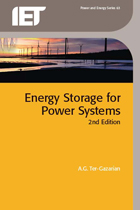
Energy Storage for Power Systems
A.G. Ter-Gazarian
The Institution of Engineering and Technology, 2011
The supply of energy from primary sources is not constant and rarely matches the pattern of demand from consumers. Electricity is also difficult to store in significant quantities. Therefore, secondary storage of energy is essential to increase generation capacity efficiency and to allow more substantial use of renewable energy sources that only provide energy intermittently. Lack of effective storage has often been cited as a major hurdle to substantial introduction of renewable energy sources into the electricity supply network. The author presents here a comprehensive guide to the different types of storage available. He not only shows how the use of the various types of storage can benefit the management of a power supply system, but also considers more substantial possibilities that arise from integrating a combination of different storage devices into a system. This book will be important to those seeking to develop environmentally sound energy resources.
[more]

Energy Storage for Power Systems
Andrei G. Ter-Gazarian
The Institution of Engineering and Technology, 1994
Energy flow from many primary sources is not constant but depends on the season, time of day and weather conditions. Energy demand also varies with the same circumstances, but generally in reverse. Obviously there needs to be some way for energy suppliers to separate the processes of energy generation and consumption, by storing energy until it is needed.
[more]
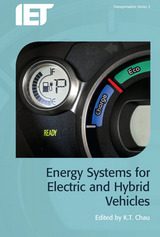
Energy Systems for Electric and Hybrid Vehicles
K.T. Chau
The Institution of Engineering and Technology, 2016
Electric and hybrid vehicles have been globally identified to be the most environmental friendly road transportation. Energy Systems for Electric and Hybrid Vehicles provides comprehensive coverage of the three main energy system technologies of these vehicles - energy sources, battery charging and vehicle-to-grid systems.
[more]
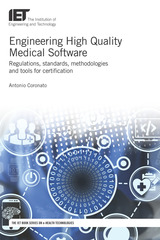
Engineering High Quality Medical Software
Regulations, standards, methodologies and tools for certification
Antonio Coronato
The Institution of Engineering and Technology, 2018
No longer confined to medical devices, medical software has become a pervasive technology giving healthcare operators access to clinical information stored in electronic health records and clinical decision support systems, supporting robot-assisted telesurgery, and providing the technology behind ambient assisted living. These systems and software must be designed, built and maintained according to strict regulations and standards to ensure that they are safe, reliable and secure.
[more]
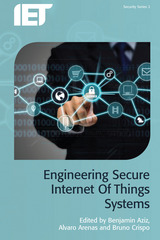
Engineering Secure Internet of Things Systems
Benjamin Aziz
The Institution of Engineering and Technology, 2016
The Internet of Things (IoT) - the emerging global interconnection of billions of 'smart' devices - will be collecting increasing amounts of private and sensitive data about our lives, and will require increasing degrees of reliability and trustworthiness in terms of the levels of assurance provided with respect to confidentiality, integrity and availability. This book examines these important security considerations for the IoT.
[more]

Engineers' Handbook of Industrial Microwave Heating
Roger Meredith
The Institution of Engineering and Technology, 1998
Heating materials using microwave energy offers many advantages in industrial processes, including improved quality, efficiency and control. There is a growing interest in microwave heating throughout industry and there are now many research establishments, both academic and industrial, working in this field. Microwave technology is a well developed science in the areas of radar and communications, supported by a large bibliography, but this is not the case for its applications to industry. The aim of this book is first to present the fundamentals of microwave technology that are relevant to industrial practice in a manner accessible to engineers, scientists and technicians who may have little or no prior knowledge of the subject. Second, it presents a perspective on the range and scope of the techniques and hardware used, giving detailed descriptions, making critical comparisons and commenting frequently on practical issues of design.
[more]
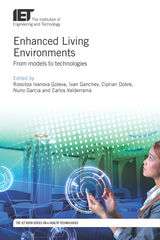
Enhanced Living Environments
From models to technologies
Rossitza Ivanova Goleva
The Institution of Engineering and Technology, 2018
Enhanced living environments employ information and communications technologies to support true ambient assisted living for adults and people with disabilities. This book provides an overview of today's architectures, techniques, protocols, components, and cloud-based solutions related to ambient assisted living and enhanced living environments. Topics covered include: an introduction to enhanced living environments; pervasive sensing for social connectedness; ethics in information and communication technologies; service scenarios in smart personal environments; technological support to stress level monitoring; big data systems to improve healthcare information searching over the Internet; sensors for wireless body area networks; linear wireless sensor networks and protocols in next generation networks; model-compilation challenges for cyber-physical systems; health monitoring using wireless body area networks; wearable health care; and intelligent systems for after-stroke home rehabilitation.
[more]

Essentials of Electromagnetic Compatibility Engineering
Randy J. Jost
The Institution of Engineering and Technology, 2016
Electromagnetic compatibility (EMC) engineering has grown rapidly as a field as systems have become smaller. More compact systems have resulted in increased interference and leakage problems, thus making it almost every design engineer's mission to seek and eliminate EMC-related problems before production commences.
[more]

Essentials of Non-linear Control Theory
J.R. Leigh
The Institution of Engineering and Technology, 1983
The book is concerned with understanding the structure of nonlinear dynamic systems within a control engineering context After a discussion of theoretical foundations, the development moves to specific techniques (describing function method, phase plane portrait, linearisation methods). The treatment then becomes oriented to qualitative analysis and maintains this emphasis to the end of the book. The broad aim is to develop methods that will allow the topology of system behaviour to be visualised. The main tools are Lyapunov methods, extending to include recent work on system decomposition. A bibliography lists both earlier seminal and recent literature to allow the reader to follow up particular aspects.
[more]
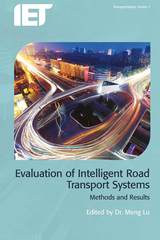
Evaluation of Intelligent Road Transport Systems
Methods and results
Meng Lu
The Institution of Engineering and Technology, 2016
Intelligent Transport Systems (ITS) use information and communications technologies (ICT) to deliver transport improvements instead of extending physical infrastructure, thereby saving money and reducing environmental impact. This book provides an overview of ICT-based intelligent road transport systems with an emphasis on evaluation methods and recent evaluation results of ITS development and deployment. Topics covered include: ITS evaluation policy; frameworks and methods for ITS evaluation; ITS impact evaluation; the network perspective; field operational tests (FOTs); assessing transport measures using cost-benefit and multicriteria analysis; technical assessment of the performance of in-vehicle systems; opportunities and challenges in the era of new pervasive technology; evaluation of automated driving functions; user-related evaluation of ADAS (Advanced Driver Assistance Systems) and automated driving; evaluation of traffic management; performance assessment of a wet weather pilot system; case studies from China; heavy vehicle overload control benefit and cost. With chapters from an international panel of leading experts, this book is essential reading for researchers and advanced students from academia, industry and government working in intelligent road transport systems.
[more]
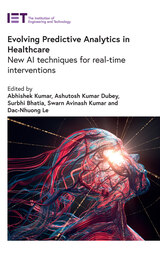
Evolving Predictive Analytics in Healthcare
New AI techniques for real-time interventions
Abhishek Kumar
The Institution of Engineering and Technology, 2022
A major use of practical predictive analytics in medicine has been in the diagnosis of current diseases, particularly through medical imaging. Now there is sufficient improvement in AI, IoT and data analytics to deal with real time problems with an increased focus on early prediction using machine learning and deep learning algorithms. With the power of artificial intelligence alongside the internet of 'medical' things, these algorithms can input the characteristics/data of their patients and get predictions of future diagnoses, classifications, treatment and costs.
[more]

Exam Preparation
Electrical Installations (2391)
The Institution of Engineering and Technology
The Institution of Engineering and Technology, 2017
This level 3 qualification helps learners develop the knowledge and practical skills required to carry out inspection and testing on electrical installations.
[more]

Exam Preparation
Electrotechnical Apprenticeship Qualification (5357)
The Institution of Engineering and Technology
The Institution of Engineering and Technology, 2017
This book has been written as an exam practice aid to complete the City & Guilds Level 3 NVQ Diploma in Electrotechnical Technology (5357).
[more]

Exam Preparation
Initial and Periodic Electrical Inspection and Testing (2391): Level 3 Award
The Institution of Engineering and Technology
The Institution of Engineering and Technology, 2023
This book is an essential practice aid for the examinations required to complete the City & Guilds qualification, Initial and Period Electrical Inspection and Testing (2391), including the three available pathways.
[more]

Exam Preparation
Requirements for Electrical Installations (2382): Level 3 Award
The Institution of Engineering and Technology
The Institution of Engineering and Technology, 2023
This book is an essential practice aid for the examinations required to complete the City & Guilds qualification, Requirements for Electrical Installations (2382).
[more]

Exam Preparation Requirements for Electrical Installations (2382-18)
The Institution of Engineering and Technology
The Institution of Engineering and Technology, 2019
This book has been written as a practice aid for the examination you will need to take to complete the Level 3 Award in Requirements for Electrical Installations: BS 7671 (2382-18).
[more]

Exhibiting Electricity
K.G. Beauchamp
The Institution of Engineering and Technology, 1997
Throughout the 19th and 20th centuries technical exhibitions, held for the benefit of both cognoscente and the general public alike, have presented a mirror to the progress of science, engineering and, towards the second half of the 19th century and throughout the 20th century, to electrical technology.
[more]

Explainable Artificial Intelligence for Trustworthy Internet of Things
Mohamed Abdel-Basset
The Institution of Engineering and Technology, 2024
A major challenge for machine learning solutions is that their efficiency in real-world applications is constrained by the current lack of ability of the machine to explain its decisions and activities to human users. Biases based on race, gender, age or location have been a long-standing risk in training AI models. Furthermore, AI model performance can degrade because production data differs from training data.
[more]
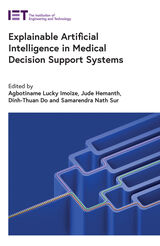
Explainable Artificial Intelligence in Medical Decision Support Systems
Agbotiname Lucky Imoize
The Institution of Engineering and Technology, 2022
Medical decision support systems (MDSS) are computer-based programs that analyse data within a patient's healthcare records to provide questions, prompts, or reminders to assist clinicians at the point of care. Inputting a patient's data, symptoms, or current treatment regimens into an MDSS, clinicians are assisted with the identification or elimination of the most likely potential medical causes, which can enable faster discovery of a set of appropriate diagnoses or treatment plans. Explainable AI (XAI) is a "white box" model of artificial intelligence in which the results of the solution can be understood by the users, who can see an estimate of the weighted importance of each feature on the model's predictions, and understand how the different features interact to arrive at a specific decision.
[more]
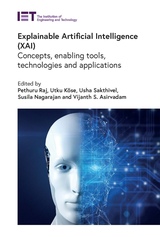
Explainable Artificial Intelligence (XAI)
Concepts, enabling tools, technologies and applications
Pethuru Raj
The Institution of Engineering and Technology, 2023
The world is keen to leverage multi-faceted AI techniques and tools to deploy and deliver the next generation of business and IT applications. Resource-intensive gadgets, machines, instruments, appliances, and equipment spread across a variety of environments are empowered with AI competencies. Connected products are collectively or individually enabled to be intelligent in their operations, offering and output.
[more]

Exploring Intelligent Healthcare with Quantum Computing
Abhishek Kumar
The Institution of Engineering and Technology, 2024
This edited book explores the field of quantum computing and machine learning for medical data processing. Topics such as security, transparency, data integrity, big data and applications in drug discovery, precision in diagnostics and precision medicine, are explored.
[more]
READERS
Browse our collection.
PUBLISHERS
See BiblioVault's publisher services.
STUDENT SERVICES
Files for college accessibility offices.
UChicago Accessibility Resources
home | accessibility | search | about | contact us
BiblioVault ® 2001 - 2024
The University of Chicago Press









